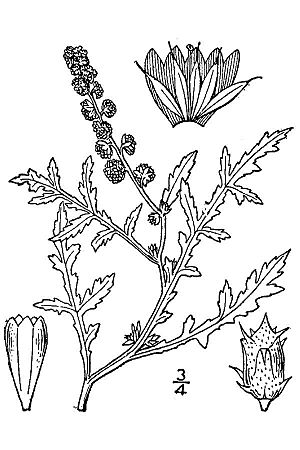Skeletonleaf bur ragweed facts for kids
Ambrosia tomentosa, also known as the skeletonleaf bur ragweed, is a type of plant found in North America. It's part of the aster family, which includes many common flowers like sunflowers and daisies. This plant is a perennial, meaning it lives for more than two years.
Skeletonleaf bur ragweed is originally from the west-central part of the United States. You can find it mainly in areas like the western Great Plains, the Colorado Plateau, and the eastern Great Basin. Sometimes, this plant is considered a noxious weed in certain states. This means it can grow in places where it's not wanted and might cause problems for other plants or crops.
Quick facts for kids Ambrosia tomentosaSkeletonleaf bur ragweed |
|
|---|---|
 |
|
| Scientific classification | |
| Genus: |
Ambrosia
|
| Species: |
tomentosa
|
| Synonyms | |
|
|
What Does Skeletonleaf Bur Ragweed Look Like?
This plant can grow quite tall, sometimes reaching up to 3 feet (about 91 cm) high. Its leaves are very interesting! They are deeply cut, almost like a skeleton, and feel fuzzy because they are covered in tiny hairs. These leaves can be as long as 5 inches (about 12.7 cm) and have small teeth along their edges.
The flowers of the skeletonleaf bur ragweed are small and yellow. After the flowers, the plant produces spiky fruits called burrs. Each burr usually contains two seeds. These burrs are designed to stick to animals or clothes, helping the seeds travel to new places.
How Does It Reproduce?
Besides making seeds, the skeletonleaf bur ragweed has another way to spread. It can also reproduce using its roots. These roots grow widely underground, allowing new plants to sprout up far from the original plant. This helps the plant spread quickly across an area.

